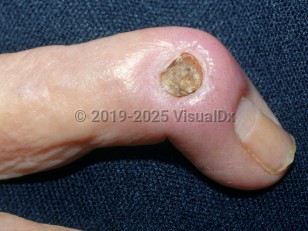Classic history and presentation: Patients may present with fever; however, 40% will be afebrile. Other symptoms include unexplained mild-to-severe bone pain, refusal to bear weight, and reduced range of motion. Although these symptoms may be prominent in an acute infection, subtler and nontoxic presentations could suggest a subacute or chronic infection.
Prevalence: Varies by region, ranging from 1 in 5000-7700 in developed countries. In the United States, an increasing proportion of infections from community-acquired, methicillin-resistant Staphylococcus aureus (MRSA) have been found.
- Age – The mean age is 6.6 years old, with approximately 40% of cases found in preschool-aged children.
- Sex / gender – Male-to-female ratio is 1.82:1.
Pathophysiology: It is suspected that both the turbulent blood flow and poorly developed reticuloendothelial system inherent to the physis may create an optimal environment for an infection. This can lead to subsequent subperiosteal abscess formation or septic arthritis if originating from within the joint capsule.
In neonates, predominant pathogens include Group B Streptococcus, S aureus, and gram-negative rods.
Approximately 90% of cases among infants and children are caused by S aureus, with increasing rates of Kingella kingae. In patients with sickle cell disease, Salmonella may cause osteomyelitis but is still less common than S aureus. In IV drug users and in cases of puncture injuries through athletic footwear, Pseudomonas may be suspected.
Grade / classification system: Pediatric osteomyelitis can be further classified by:
- Patient age: neonatal, childhood
- Onset: acute, subacute, chronic (longer than 1 month)
- Causative organism: pyogenic, granulomatous
- Route of infection: hematogenous, contiguous, direct


 Patient Information for
Patient Information for 
